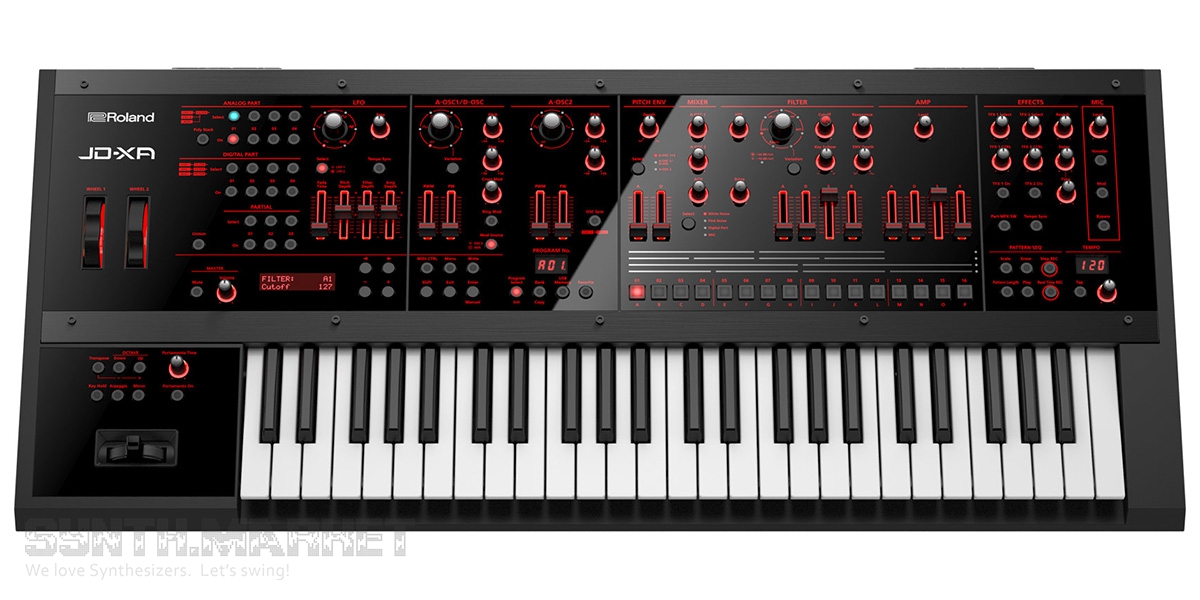Первый синтезатор корпорации Роланд, на котором в 2015г. была представлена новейшая технология сочетаемого синтеза звука. Создатели нарекли своё детище "crossover synth", что поэтично эквивалентно "перекресток двух миров", а именно аналогового и цифрового синтеза звука. Именно так, это не просто гибридный синтезатор, как бывало ранее, например цифровые осцилляторы (или волновые таблицы) и аналоговые фильтры, или аналоговые осцилляторы и цифровые эффекты поверх. Это полнофункциональное сочетание "два-в-одном", т.е. 2 синтезатора, аналоговый и цифровой, достаточно сильно взаимодействующие между собой и помещенные в один корпус.
Основной из них, по мнению большинства специалистов - это, конечно, цифровой синтезатор, работающий на технологии SuperNATURAL, имеющий полифонию в 64 голоса и 4-частную мультитембральность, причем каждая из частей имеет 3 подчиненные к ней (итого 12 связанных частей). Волновые формы генераторов - стандартные пила, прямоугольная волна, меандр с ШИМ, треугольная волна, синусоидальная волна, а также сочетание волн.
Аналоговый синтезатор обладает достаточно развитой архитектурой, которую, тем не менее, не сравнить по сложности с признанными лидерами, например DSI Prophet `08 или даже Modal 008. JD-XA имеет, по всей видимости, аналоговые генераторы с цифровым управлением, которые Роланд умышленно называет просто OSC, т.е., явно не раскрывает их тип. Это слегка "мутит" общественность, которая в итоге не может понять, почему не написать сразу DCO? Или все же использованы не совсем классические по построению DCO, или даже цифровые, но тогда рушится сам концепт "аналог+цифра"? Тем не менее, голосов 4, генераторов на плате также 4. Волновые формы генераторов - стандартные пила, прямоугольная волна, меандр с ШИМ, треугольная волна, синусоидальная волна. Генератор низкой частоты (LFO) также имеет широкий выбор волновых форм - треугольная волна, синусоида, пилообразная волна, прямоугольная волна, S&H, Random. Аналоговая мультитембральность - 4 части.
Поражает обилие фильтров в обоих синтезаторах, которые, к слову говоря, аналоговые. Есть 3 вида LPF; HPF, BPF, байпас для обоих синтезаторов, и Variation для цифрового синтезатора. JD-XA имеет также ADSR-огибающие для фильтров и усиления и AD для высоты тона, большой выбор эффектов, мощный паттерн-секвенсер с поддержкой импорта нотных файлов стандарта SMF, обширные возможности арпеджио.
Что касается интерфейсов - то тут все в полном порядке. Синтезатор обладает четырёхоктавной динамической клавиатурой с послекасанием. На лицевой панели продуманно расположены разные контроллеры - кнопки, энкодеры и слайдеры для всех основных функций. Есть как общий стерео аудио-выход, так и отдельный для аналогового синтезатора, 2 назначаемых колеса и рычажок высоты тона/ модуляции, вход и выход МИДИ, оба порта USB (и на компютер, и для накопителя), а также многорежимные выходы CV/ Gate для передачи сигналов управления на аналоговые синтезаторы и секвенсеры.
Вариативность JD-Xa позволяет ему как хамелеону подстраиваться под новые тенденции, ведь, в отличие от классического аналогового синтезатора, который после выпуска живет одной жизнью до ревизии или снятия с производства, в гибридном синтезаторе достаточно обновить программную часть, и вот уже он снова в строю.
Кроме того, Roland JD-XA просто красавец, хотя и не дотягивает до шикарного Fantom с его легкосплавным корпусом, но все же очень сексапилен в своем черном пластиковом корпусе с глянцевыми панелями и красной подсветкой. И вживую он очень гармонично смотрится - имеет идеальные размеры, продуманную эргономику и небольшой вес. Пробуйте, не пожалеете!
Метки: гибридный синтезатор












